Kroatien |
|
|
|
| Übersicht – Contents: | |
Diese Seite ist Teil des Projektes
Kroatien |
|
|
|
| Übersicht – Contents: | |
Flaggen – Flags: |
|
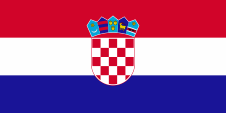 |
National- und Staatsflagge – national and state flag, Seitenverhältnis – ratio = 1:2, Quelle/Source, nach/by: Flags of all Nations   |
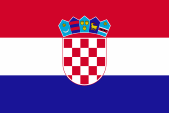 |
Handelsflagge und Staatsflagge zur See – merchant flag and state flag offshore, Seitenverhältnis – ratio = 2:3, Quelle/Source, nach/by: Flags of all Nations |
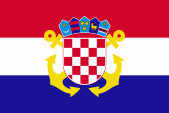 |
Marineflagge - naval flag, Seitenverhältnis – ratio = 2:3, Quelle/Source, nach/by: Wikipedia (D) |
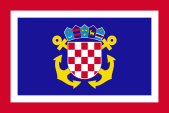 |
Gösch – Jack, Seitenverhältnis – ratio = 2:3, Quelle/Source, nach/by: Wikipedia (D) |
historische und regionale Flaggen – historical and regional Flags: |
|
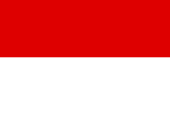 |
bis/to 1849, |
 |
bis/to 1849, |
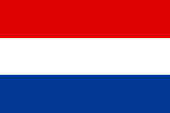 |
1868–1918, |
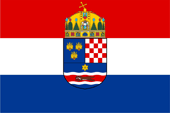 |
1868–1918, |
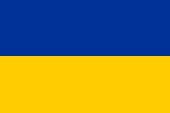 |
1820–1918, |
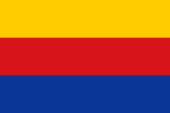 |
1849–1918, |
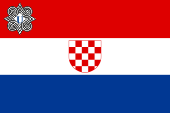 |
1941–1945, |
 |
1941–1945, |
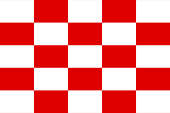 |
1941–1945, |
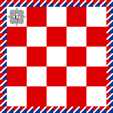 |
1941–1945, |
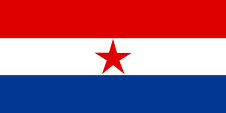 |
1945–1947, |
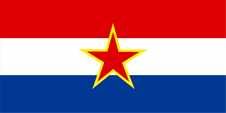 |
1947–1990, |
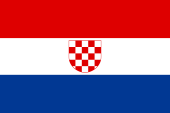 |
1990, |
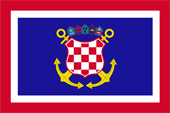 |
1992–1999, |
Bedeutung/Ursprung der Flagge – Meaning/Origin of the Flag: |
|
|
Die heutige Flagge Kroatiens wurde am 22.12.1990 offiziell eingeführt. Sie
zeigt drei waagerechte Streifen in Rot, Weiß und Blau, und in der Mitte das
Staatswappen. Die Buntfarben sind heute unter anderem in Pantone PMS definiert, als Rot = pt 186, Hellblau = Cyan, Blau = pt Reflex Blue, Gelb = pt 108. Für die historischen Flaggen kann das auf Grund der damals fehlenden Standards jedoch nicht gelten. |
The today's flag of Croatia was officially introduced on the 22nd of
December in 1990. It shows three horizontal stripes in red, white and blue,
and in the middle the coat of arms. The chromatic colors are nowadays among others defined in Pantone PMS, as red = pt 186, light blue = cyan, blue = pt reflex blue, yellow = pt 108. However, this cannot apply to the historical flags due to the lack of standards at that time. |
| Die traditionellen Farben Kroatiens sind Rot und Weiß. Sie leiteten sich vom kroatischen Wappenschild ab. Nach dem Erstarken des slawischen Nationalismus war auch Kroatien bestrebt eine dreifarbige Flagge in den Farben Rot, Weiß und Blau zu schaffen (siehe weiter unten im Text). |
The traditional colours of Croatia are red and white. They were derived from
the Croatian blazon. After the growing of the Slavic nationalism was Croatia also engaged to create a three-colored flag in the colours red, white and blue (look underneath in the text). |
| Diese wurde bei Gelegenheit des österreichisch-ungarischen Ausgleichs offiziell angenommen, denn bei der Vereinigung Kroatiens und Slawoniens zum Königreich Kroatien-Slawonien im Jahre 1868 wurden die Farben Kroatiens (Rot und Weiß) und Slawoniens (Blau und Weiß) zur Kombination Rot-Weiß-Blau vereinigt. | That was adoped officially on occasion of the Austria-Hungaryn Conciliation, because when Croatia and Slavonia became merged into the Kingdom of Croatia-Slavonia in 1868, the colours of Croatia (red and white) and Slavonia (blue and white) were combined to the colour combination of red-white-blue. |
| Viele slawische Völker schufen sich in der Zeit nach 1848 (dem Jahr der Revolutionen) – im Zusammenhang mit einem erstarkenden slawischen Nationalismus – eigene Flaggen. Dabei spielte der Panslawismus eine bedeutende Rolle, eine politische Bewegung des 18./19. Jahrhunderts, die alle Slawen in einer Nation einen wollte. Die meisten slawischen Völker lebten jedoch in dieser Zeit unter österreichischer, türkischer oder auch deutscher Herrschaft. Der Panslawismus sah in Russland ein Vorbild, denn die Russen waren, neben Serbien und Montenegro, die einzige freie slawische Nation. Und so wurden die Farben der russischen Flagge zum Idol der Panslawisten, und letztlich farbliches Vorbild bei der Gestaltung der Flaggen vieler slawischer Nationen. Diese Flaggen trugen und tragen bis auf wenige Ausnahmen die russischen Farben Weiß, Blau und Rot als gemeinsames Merkmal. Daher wird diese Farbkombination "Panslawische Farben" genannt. |
Many Slavic nations create on the 19th century own flags – in context with a
growing Slavic nationalism. Thereby played the Panslavism an important roll,
a political movement of the 18th/19th century, which would unite all Slavs
in one nation. The most Slavic nations however lived in this times under Austrian, Turkish or even German rule. The Panslavism saw in Russia a model, because the Russians were, apart from Serbia and Montenegro, the only free Slavic nation. In this way the colours of the Russian flag became to an idol of the Panslavists, and in the end to a colour's pattern in the designing of the flags of many Slavic nations. Those flags carried and carry except few exceptions the Russian colours white, blue and red as mutual attribute. From there this colour's combination is named "Panslavic Colours". |
| Nachdem Jugoslawien 1941 von deutschen Truppen überrannt und zerschlagen worden war, ergriff in Kroatien die Nationalbewegung Ustascha die Macht, und Kroatien wurde ein eigenständiger Staat. Die rot-weiß-blaue Flagge wurde durch das kroatische Wappenschild ergänzt, und auf der Staats- und Kriegsflagge wurde im oberen roten Streifen nahe dem Flaggenmast sogar noch das Zeichen der Ustascha hinzugefügt. |
After Yugoslavia was overrun and shattered by German troops in 1941, in
Croatia seizures the national movement of Ustascha the power, and Croatia
became an independent state. The red-white-blue flag was supplemented by the Croatian blazon and on the state and war flag was even added in the upper red stripe near the flagstaff the symbol of the Ustasha. |
| Nach der Machtergreifung durch die Kommunisten wurde anstelle des Wappens ein fünfzackiger roter, goldumrandeter Stern (Symbol der kommunistischen Partisanen des Zweiten Weltkriegs und Symbol des Kommunismus) in der Mitte der Flagge angebracht. | After the seizure of power by the communists was fixed in the mittle of the flag instead of the coat of arms a five-pointed red, gold-rimmed star (symbol of the communist partisans of the Second World War and symbol of the communism). |
| Nach dem Ende des Kommunismus wollte man in Kroatien am 26.06.1990 heraldisch wieder auf die Wurzeln zurückgehen und die Veränderungen an den Hoheitszeichen des Landes rückgängig machen. Dazu setzte man in der vorsozialistischen Ära wieder an und führte das vor dem Sozialismus gültige Wappen wieder ein und platzierte es an Stelle des roten Sterns in die Mitte der Flagge. Dazu gab es Kritik im In- und Ausland, denn es werde Eindruck erweckt, dass Ustascha-Symbolik wieder zum Leben erweckt werden würde. Das war natürlich Unsinn, denn das alte kroatische Wappenschild reicht weit in die Geschichte zurück, nämlich bis ins 15. Jahrhundert. Dennoch wurde das in der Zeit des Sozialismus (1947–1990) verwendete Wappenschild am 21.10.1990 wieder eingeführt. Es beginnt oben links nicht mit einem weißen Feld, sondern mit Rot. | After the end of communism in Croatia
they wanted to go back to their roots on 26th of June in 1990 and undo the
changes in the national emblems. To do this they went back to the
pre-socialist era, and that was done by reintroducing that coat of arms
which was used before socialism and it was placed in the center of the flag
instead of the red star. There was criticism in inland and abroad, because
it would give the impression that the symbolism of Ustasha would be brought
back to life. That was big nonsense, because the old Croatian coat of arms goes far back into history, namely to the 15th century. Nevertheless, the heraldic shield which was used in the period of socialism (1947-1990) was reintroduced on 21st of October in 1990. It starts at the top left not with a white field, but with red. |
|
Dazu wurde noch eine Wappenkrone aus fünf einzelnen Wappen oberhalb des
Schildes ergänzt. Sie zeigt die Wappen von Illyrien, ein altes, wenig bekanntes Wappen der Stadt Dubrovnik (Ragusa), das Wappen des Königreichs Dalmatien, das Wappen von Istrien und das Wappen des Königreichs Slawonien. |
Furthermore a crown - made of coats of arms - was added above the shield, showing five heraldic shields. These are the coat of arms of Illyria, an old and not so well known coat of arms of the city of Dubrovnik (Ragusa), the coat of arms of the Kingdom of Dalmatia, the coat of arms of Istria and the coat of arms of the Kingdom of Slavonia. |
| Quelle/Source: Die Welt der Flaggen, Flaggen und Wappen der Welt, Wikipedia (EN), Volker Preuß | |
Wappen – Coat of Arms: |
|
 |
bis/to 1945, Wappenschild von Kroatien – blazon of Croatia, Quelle/Source, nach/by: Wikipedia (EN) |
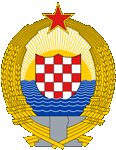 |
1947–1990, Wappen von Kroatien – coat of arms of Croatia, Quelle/Source: Nanin7 [GFDL or CC BY-SA 3.0], from Wikimedia Commons |
 |
seit/since 1990, Wappenschild von Kroatien – blazon of Croatia, Quelle/Source, nach/by: Wikipedia (EN) |
Bedeutung/Ursprung des Wappens – Meaning/Origin of the Coat of Arms: |
|
| Das typische Wappen Kroatiens, der schachbrettartig in Weiß und Rot aufgeteilte Wappenschild, stammt aus dem 15. Jahrhundert. | The typical coat of arms of Croatia, the between white and red checkerboard styled blazon, descends from the 15th century. |
| Das Bild des Wappens geht wahrscheinlich auf den Deutschen Kaiser Maximilian I. zurück, der 1491 den Titel des Königs von Ungarn und seiner Nebenländer erhielt. Wahrscheinlich hat Maximilian I. in diesem Zusammanhang ein Wappen für das Königreich Kroatien entwickeln lassen. | The image of the coat of arms goes probably back to the German Emperor Maximilian I., who was awarded the title of the King of Hungary and his minor lands in the year 1491. It is probable that Maximilian I. had in this context developed a coat of arms for the Kingdom of Croatia. |
| Nach der Machtergreifung durch die Kommunisten wurde das Wappenschild neu umgestaltet. Es beginnt oben links nicht mit einem weißen Feld, sondern mit Rot. Das Wappen selbst wurde nach dem Vorbild des Wappens der Sowjetunion neu gestaltet. |
After the seizure of power by the Communists, the blazon was redesigned. It starts at the top left not with a white field, but with red. The coat of arms itself was redesigned after the model of the coat of arms of the Soviet Union. |
| Nach dem Ende des Kommunismus wollte man in Kroatien am 26.06.1990 heraldisch wieder auf die Wurzeln zurückgehen und die Veränderungen an den Hoheitszeichen des Landes rückgängig machen. Dazu setzte man in der vorsozialistischen Ära wieder an und führte das vor dem Sozialismus gültige Wappen wieder ein. Dazu gab es Kritik im In- und Ausland, denn es werde Eindruck erweckt, dass Ustascha-Symbolik wieder zum Leben erweckt werden würde. Das war natürlich Unsinn, denn das alte kroatische Wappenschild reicht weit in die Geschichte zurück, nämlich bis ins 15. Jahrhundert. Dennoch wurde das in der Zeit des Sozialismus (1947–1990) verwendete Wappenschild am 21.10.1990 wieder eingeführt. | After the end of communism in Croatia
they wanted to go back to their roots on 26th of June in 1990 and undo the
changes in the national emblems. To do this they went back to the
pre-socialist era, and that was done by reintroducing that coat of arms
which was used before socialism. There was criticism in inland and abroad, because
it would give the impression that the symbolism of Ustasha would be brought
back to life. That was big nonsense, because the old Croatian coat of arms goes far back into history, namely to the 15th century. Nevertheless, the heraldic shield which was used in the period of socialism (1947-1990) was reintroduced on 21st of October in 1990. |
| Das Wappenschild
trägt seit dem eine Wappenkrone. Die kleinen Schilde in der Wappenkrone symbolisieren
verschiedene geographische Regionen Kroatiens: 1.) goldener sechszackiger Stern und silberner Halbmond auf hellblauem Schild → Zagreb (Agram) und Umgebung (Illyrien); 2.) blauer Schild mit zwei roten Balken → Dubrovnik (Ragusa); 3.) drei gekrönte goldene Löwenköpfe im hellblauen Schild → Dalmatien; 4.) goldener Ziegenbock mit roten Hörnern im blauen Schild → Istrien; 5.) ein Marder in einem durch schmale silberne Streifen vom hellblauen Schild getrennten roten Feld und darüber ein goldener sechszackiger Stern → Slawonien. |
Above the shield is since
then furthermore placed a
scutcheon-crown. The small shields in the scutcheon-crown symbolize diverse
geographical regions of Croatia: 1.) golden six-pointed star and silvery half-moon on pale blue blazon → Zagreb (Agram) and surroundings (Illyria); 2.) blue blazon with two red bars → Dubrovnik (Ragusa); 3.) three crowned golden lion's heads in pale blue blazon → Dalmatia; 4.) golden goat buck with red horns in blue blazon → Istria; 5.) a marten in a by narrow silvery stripes from the pale blue blazon separated red field and above that a golden six-pointed star → Slavonia. |
| Quelle/Source: Flaggen Wappen Hymnen, Flaggen und Wappen der Welt, Wikipedia (EN), Volker Preuß | |
Flugzeugkokarde – aircraft roundel: |
|
 |
seit/since 1994, Flugzeugkokarde – aircraft roundel Quelle/Source, nach/by Wikipedia (EN) |
 |
1991–1994, Flugzeugkokarde – aircraft roundel Quelle/Source, nach/by Wikipedia (EN) |
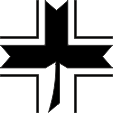 |
1941–1945, Flugzeugkokarde – aircraft roundel Quelle/Source, nach/by Wikipedia (EN) |
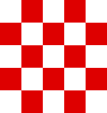 |
1941, Flugzeugkokarde – aircraft roundel Quelle/Source, nach/by Wikipedia (EN) |
Landkarten – Maps: |
Lage – Position: |
Landkarte des Landes – Map of the Country: |
Die Staaten des früheren Jugoslawien – The countries of former Yugoslavia: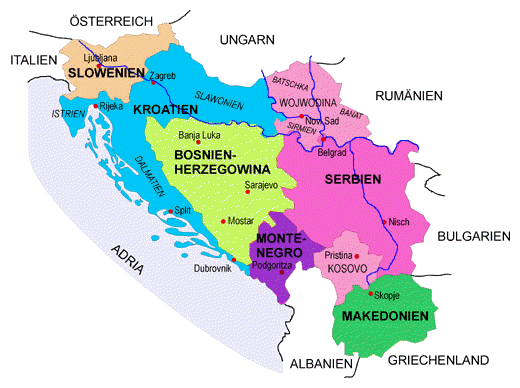 Landkarte/Map: Volker Preuß |
| Zahlen und Fakten – Numbers and Facts: | |
|
|
|
|
|
|
|
|
|
|
|
|
|
|
|
|
|
|
|
|
| Antike ·
von Illyrern besiedelt 1. Jhd. v.Chr. · Unterwerfung der illyrischen Küste durch Rom bis ca. 14 · Unterwerfung ganz Illyriens durch das Römische Reich 395 · bei der Teilung des Römischen Reiches kommt das heutige Kroatien an das Weströmische Reich 380 und 455–553 · zum Reich der Ostgoten bis 568 · teilweise zum Reich der Langobarden 7. Jhd. · Einwanderung der Kroaten, wahrscheinlich aus dem Gebiet der Weichsel (heutiges Polen) ca. 900 · das heutige Kroatien kommt an das Oströmische Reich (Byzanz) 924 · Gründung des Königreiches Kroatien durch Tomislaw 1091/1102 · Kroatien kommt an Ungarn 1526 · Schlacht bei Mohács, Ungarn unterliegt dem Osmanischen Reich, Österreich kann große Teile Kroatiens sichern und erwirbt die Ungarische Krone, der größte Teil Ungarns wird dem Osmanischen Reich angegliedert 1527 · das Haus Habsburg wird als Herrscherhaus (Könige) Kroatiens anerkannt 1699 · Frieden von Karlowitz, die Habsburger als Könge von Ungarn erwerben ganz Kroatien und Slawonien, Slawonien wird ebenfalls Königreich 1797–1809 · Französische Revolutionskriege: ein Teil Österreichs (Steiermark) wird 1797 von den Franzosen besetzt 12.05.1797 · Friede von Campo Formio zwischen Österreich (Haus Habsburg) und Frankreich (Napoléon I.), Dalmatien kommt von Venedig an das Haus Habsburg 1809 · Friede von Wien, Österreich verliert Salzburg, das Innviertel, Westgalizien und Teile von Ostgalizien und tritt Istrien, Triest, Görz, Krain, Kärnten, Kroatien, und Dalmatien an Frankreich ab, die 1810 zu den französischen "Illyrischen Provinzen" zusammengefasst werden 1813 · Österreich erklärt Frankreich (Napoléon) den Krieg 1814/1815 · Wiener Kongress, Neuordnung Europas nach der Ära Napoléon, das Kaiserreich Österreich (Haus Habsburg) erhält die 1809 verlorenen Gebiete zurück; Istrien, Triest, Görz, Kärnten und Krain werden zum Habsburgischen Königreich Illyrien zusammengefasst, Dalmatien und Kroatien werden wieder an Ungarn (unter den Habsburgern, Teil des Kaiserreichs Österreich) angeschlossen 1848/1849 · Revolution in Wien, Bürgerkrieg zwischen Ungarn und Kroaten, Aufstände in Prag, Mailand und Venedig, daraufhin dankt Kaiser Ferdinand I. ab und Franz Joseph I. von Habsburg wird neuer Kaiser, die Aufstände werden niedergeschlagen und er erlässt eine neue Verfassung: die Titular-Erblande der Habsburger im Kaiserreich Österreich werden zu Kronländern mit eigenen Landtagen umgewandelt, der dalmatische Landtag lehnt den Anschluss an Kroatien ab, das Königreich Dalmatien wird ein eigenes Kronland der österreichischen Krone, Kroatien und Slawonien werden unter Einschluss der Küstengebiete und der Stadt Fiume zum "Königreich Kroatien und Slawonien" vereinigt, das als Nebenland bei der ungarischen Krone verbleibt, Auflösung des Königreichs Illyrien: Aufteilung in die Kronländer Krain, Kärnten, Küstenland, Kroatien und Slawonien und Dalmatien 08.02.1867 · Österreichisch-Ungarischer Ausgleich, gleiches Recht für beide Landesteile, Entstehung der Doppelmonarchie Österreich-Ungarn, Österreich: bestehend aus den österreichischen Kronländern, Ungarn: bestehend aus Ungarn selbst und seinen Nebenländern, das Haus Habsburg stellt in einer Person den Kaiser von Österreich und den König von Ungarn, Einrichtung von gemeinsamen Ministerien in Außenpolitik, Finanzen und Verteidigung 1868 · Ungarisch-Kroatischer Ausgleich, Kroatien und Slawonien verbleiben zusammen als Königreich "Kroatien-Slawonien" unter der ungarischen Krone, Fiume wird freie Stadt (quasi Kronland) innerhalb Ungarns 1918 · Ende des Ersten Weltkriegs, Zusammenbruch der Kaiserlich-Königlichen Monarchie, Zerfall von Österreich-Ungarn in Nationalstaaten, Vereinigung von Kroatien/Slawonien mit Slowenien und Serbien zum "Königreich der Serben, Kroaten und Slowenen" (ab 1929 Jugoslawien genannt), König wird der König Serbiens 1941 · Jugoslawien wird im Verlauf des Zweiten Weltkriegs aufgelöst, Kroatien wird ein unabhängiger Staat unter Ante Pavelic, dem Führer der kroatischen Nationalbewegung (Ustascha), Kroatien erhält Bosnien-Herzegowina angegliedert und tritt am 15.06.1941 auf der Seite der Achsenmächte (Deutschland, Italien, Japan) in den Zweiten Weltkrieg ein 1941–1946 · Jugoslawien ist während des Zweiten Weltkriegs Schauplatz eines erbarmungslosen Partisanen- und Bürgerkriegs zwischen Kommunisten (unter J.B.Tito), Republikanern, Monarchisten und Nationalisten, die Kommunisten setzen sich durch 09.05.1944 · Ausrufung des Bundesstaats Kroatien 29.11.1945 · Ausrufung der "Föderativen Volksrepublik Jugoslawien" durch Tito 31.01.1946 · Ausrufung der Volksrepublik Kroatien (innerhalb des kommunistischen Jugoslawiens) 09.06.1963 · Ausrufung der Sozialistischen Republik Kroatien (innerhalb des kommunistischen Jugoslawiens) 25.07.1990 · Ausrufung der Republik Kroatien 25.06.1991 · das kroatische Parlament erklärt die Unabhängigkeit des Landes, Krieg gegen das serbisch dominierte Jugoslawien, serbisch-jugoslawische Truppen besetzen ein Drittel des Landes (Westslawonien und Krajina) 1991–1992 · ganz Jugoslawien löst sich in seine Einzelstaaten auf 1992 · Stationierung von UNO-Friedenstruppen 1995 · Kroatische Offensive, es gelingt die meisten besetzten Gebiete zu befreien 21.11.1995 · Friedensabkommen von Dayton 1998 · Wiedereingliederung von Ostslawonien 01.07.2013 · Kroatien wird Mitglied der Europäischen Union |
| antique ·
settlement by Illyrians 1st cent. B.C. · subjection of the Illyrian coast by Rome to ca. 14 · subjection of whole Illyria by the Roman Empire 395 · at the partition of the Roman Empire the today's Croatia comes to the West Roman Empire 380 and 455–553 · to the Empire of the Eastern Goth to 568 · partially to the Empire of the Langobards 7th cent. · immigration of the Croats, probably from the region of Weichsel River (today's Poland) ca. 900 · the today's Croatia comes to the East Roman Empire (Byzantium) 924 · foundation of the Kingdom of Croatia by Tomislav 1091/1102 · Croatia comes to Hungary 1526 · battle near Mohács, Hungary succumbs the Ottoman Empire, Austria secures big parts of Croatia and acquires the Hungarian crown, the largest part of Hungary becomes incorporated into the Ottoman Empire 1527 · the House of Habsburg is recognized as ruling dynasty (Kings) of Croatia 1699 · Peace of Karlovitz, the Habsburgs as Kings of Hungary purchase whole Croatia and Slavonia, Slavonia becomes also a kingdom 1797–1809 · French Revolutionar Wars, parts of Austria (Styria) become occupied by the French in 1797 12th of May 1797 · Peace of Campo Formio between Austria (House of Habsburg) and France (Napoléon I.), Dalmatia comes from Venice to the House of Habsburg 1809 · Peace of Vienna, Austria loses Salzburg, the Inn Quarter, Western Galicia and parts of Eastern Galicia and cedes Istria, Trieste, Gorizia, Carniola, Carinthia, Croatia, and Dalmatia to France, which were merged in 1810 to the French "Illyrian Provinces" 1813 · Austria declares war on France (Napoléon) 1814/1815 · Congress of Vienna, realignment of Europe after the era Napoléon, the Empire of Austria (House of Habsburg) acquires back the in 1809 lost territories; Istria, Trieste, Gorizia, Carinthia and Carniola become merged to the Habsburg's Kingdom of Illyria, Dalmatia and Croatia become re-annexed to Hungary (under the Habsburgs, part of the Empire of Austria) 1848/1849 · revolution in Vienna, civil war between Hungarians and Croats, riotings in Prague, Mailand and Venice, as a result of that Emperor Ferdinand I. resigns and Franz Joseph I. of Habsburg becomes new Emperor, the riotings become suppressed and he enacts a new constitution: the titular hereditary territories of the Habsburgs in the Austrian Empire become converted to crown lands with their own Landtag (parliament), the Landtag of Dalmatia rejects the annexion to Croatia, the Kingdom of Dalmatia becomes an own crown land of the Austrian crown, Croatia and Slavonia become united by inclusion of the coastal regions and the City of Fiume to the "Kingdom of Croatia and Slavonia", which remains as a subsidiary country under the Hungarian crown, dissolution of the Kingdom of Illyria: division in the crown lands of Carniola, Carinthia, Littoral, Croatia and Slavonia and Dalmatia 8th of February in 1867 · Austro-Hungarian Compromise, equal rights for both parts of the empire, nascence of the double monarchy of Austria-Hungary, Austria: consisting of the Austrian crown lands, Hungary: consisting of Hungary itself and its subsidiary countries, the House of Habsburg sets in one person the Emperor of Austria and the King of Hungary, establishment of common ministries in foreign affairs, finance and defense 1868 · Hungarian-Croatian Compromise, Croatia and Slavonia remain together as the Kingdom of "Croatia-Slavonia" under the Hungarian crown, Fiume becomes a free city (quasi crown land) within Hungary 1918 · end of the First World War, breakdown of the imperial-royal monarchy, disintegration of Austro-Hungary into national states, unification of Croatia/Slavonia with Slovenia and Serbia to the "Kingdom of the Serbs, Croats and Slovenes" (since 1929 named Yugoslavia), King becomes the King of Serbia 1941 · Yugoslavia gets dissolved during the Second World War, Croatia becomes an independent state under Ante Pavelic, the Leader of the Croatian national movement (Ustasha), Croatia becomes incorporated Bosnia-Hercegovina and joines in the Second World War on 15th of June in 1941 on the side of the Axis Mights (Germany, Italy, Japan) 1941–1946 · Yugoslavia is during the Second World War location of a merciless partisan and civil war between communists (under J.B.Tito), republicans, monarchists and nationalists, the communists prevailed 9th of May in 1944 · proclamation of the Federal State of Croatia 29th of November in 1945 · proclamation of the "Federative People's Republic of Yugoslavia" by Tito 31st of January in 1946 · proclamation of the People's Republic of Croatia (within communist Yugoslavia) 9th of June in 1963 · proclamation of the Socialist Republic of Croatia (within communist Yugoslavia) 25th of July in 1990 · proclamation of the Republic of Croatia 25th of June 1991 · the Croatian parliament declares the independence of the country, war against the by Serbia dominated Yugoslavia, Serbian-Yugoslav troops occupy a third of the country (Western Slavonia and Krajina) 1991–1992 · whole Yugoslavia dissolves into its particular states 1992 · deploy of UNO peace troops 1995 · Croatian offensive, they succeed to liberate the most occupied territories 21st of November in 1995 · Peace Treaty of Dayton 1998 · re-incorporation of Eastern Slavonia 1st of July in 2013 · Croatia is a member of the European Union |
| Quelle/Source: Atlas zur Geschichte, Wikipedia (D), World Statesmen |
| die Kronländer Österreich-Ungarns – Crown Lands of Austria-Hungary: |
|
| Quelle/Source: Volker Preuß |
| Der Name "Kroatien" kommt natürlich vom Volk der "Kroaten", die sich selbst "Hrvati" nennen. Das Wort "Hrvati" ist indo-germanischen Ursprungs und ist am nächsten verwandt mit dem altiranischen Wort "Fshuhaurvata", was "Viehüter" heißt. | The name
"Croatia" comes naturally from the people of the "Croats", which name
themselves "Hrvati". The word "Hrvati" is from Indo-German origin and is near related with the Olt Iranian word "Fshuhaurvata", what means "herdsman". |
| Quelle/Source: Handbuch der geographischen Namen | |
Slawonien |
|
|
|
 |
bis/to 1849, |
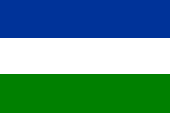 |
1868–1918, |
 |
1699–1849, |
|
|
| Zunächst hieß das gesamte Gebiet zwischen Save und Drau mit lateinischem Namen Slawonien, was noch auf die Besiedlung durch slawische Stämme im 7. Jahrhundert zurückgeht. Seit dem 12. Jahrhundert gehörte die Region zu Ungarn und seit dem 16. Jahrhundert nannte sich der ungarische König auch König von Slawonien. Noch im 16. Jahrhundert wurde Slawonien vom Osmanischen Reich erobert, außer der Region um Agram (Zagreb), die auch Illyrien (Altkroatien, Kroatien) genannt wird. Der Name Slawonien wurde darauf hin nur noch für den Osmanischen Teil im Osten des Landes verwendet. Im Jahre 1699 wurde Slawonien von Österreich erobert und als Königreich angegliedert. Im Zuge des österreichisch-ungarischen Ausgleichs von 1867 kam das Land an die ungarische Krone und wurde 1868 mit Kroatien zum Königreich Kroatien-Slawonien vereinigt. | Initially, the entire area between
the rivers Save and Drava was called Slavonia with the
Latin name, which dates back to the settlement by Slavic
tribes in the 7th century. Since the 12th century, the region has belonged to Hungary and since the 16th century, the Hungarian king has also called himself King of Slavonia. Even in the 16th century, Slavonia was conquered by the Ottoman Empire, except for the region around Agram (Zagreb), which was also called Illyria (Old Croatia, Croatia). The name Slavonia was then used only for the Ottoman part in the east of the country. In 1699, Slavonia was conquered by Austria and annexed as a kingdom. In the course of the Austria-Hungaryn compensation of 1867, the country came to the Hungarian crown and was united with Croatia in 1868 to form the Kingdom of Croatian Slavonia. |
Lage Slawoniens im heutigen Kroatien – position of Slavonia in today's Croatia: Landkarte, Quelle / Map Source: Tomobe03 [CC BY-SA 3.0], from Wikimedia Commons |
|
Istrien |
|
|
|
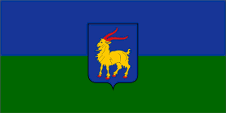 |
seit/since 03.10.1994, Flagge der kroatischen Gespanschaft Istrien – flag of the Croatian District of Istria, Seitenverhältnis = 1:2, Quelle/Source: nach/by Wikipedia (D) |
 |
bis/to 1918, Landesflagge (Landesfarben) – Flag of the country (colours), Seitenverhältnis – ratio = 2:3, Quelle/Source nach/by: Flags of the World |
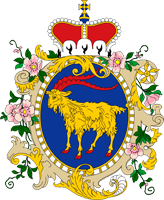 |
ca.1890–1918, Wappen der Markgrafschaft Istrien – Coat of arms of the Margraviate of Istria, Quelle/Source, nach/by: Ströhl, Wappenrolle Österreich-Ungarns, 1890, via Wikipedia (D) |
|
|
| Das Wappen zeigt eine goldene Ziege mit roter Bewehrung auf einem blauem Schild. Das Wappenbild geht auf die Venezianer zurück, die den westlichen Teil von Istrien vom 9. Jahrhundert bis 1797 beherrschten. Das Kronland Istrien verwendete als Landesfarben eine Flagge die drei horizontale Streifen in Gold, Rot und Blau zeigte, den Farben des Wappens. Die Flagge der kroatischen Gespanschaft Istrien zeigt das Wappen zwar auch, jedoch auf einer horizontal blau-grün gestreiften Flagge. |
The coat of arms shows a golden red armoured goat on a blue shield. The coat of arms goes back to the Venetians, who ruled the western part of Istria from the 9th century until 1797. The Crown land of Istria used a flag with three horizontal stripes in gold, red and blue, the colours of the coat of arms. The flag of the Croatian County of Istria also shows the coat of arms, but on a horizontally blue-green striped flag. |
| mehr Infos/more Info → hier klicken/click here → Istrien / Istria | |